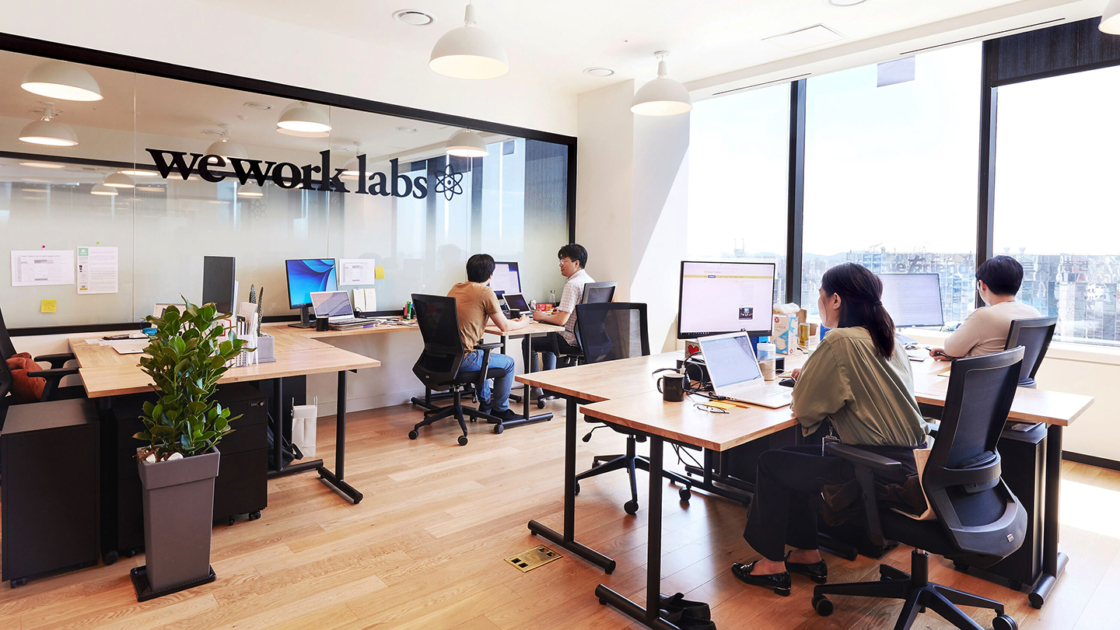Superpower on the Side features WeWork team members and how they spend their time when they’re not at work.
In 2015, Tom Clark was at a Halloween party at New York’s Hammerstein Ballroom when he saw something he still hasn’t forgotten: a man wearing a giant plastic acrylic cat head.
Clark was so intrigued that he went over and asked the wearer about his look—and learned the mask was made by an artist named Max Steiner and had a name, Kung Pow Meow. But what Clark, a principal software engineer at WeWork, really wanted to know was how Steiner had managed to give the feline figure its striking prismatic-rainbow look.
“It got stuck in my head. I was like, How do I make this?” says Clark, 37. “What if I made it join perfectly together? I knew I would need, like, a crazy precision for that.”
In fact, Clark knew just the thing. After studying theoretical mathematics in college, he moved to California to work in construction. While on the West Coast, Clark also got a job as a technical service technician for a dental supply company. It was there that he became familiar with Computer Numerical Control (CNC) Milling, a form of drilling done by computer that allows near-perfect precision.
“Modern dentistry uses [similar] CNC machines to make the crowns that go in your mouth,” says Clark. “Feel how smooth your teeth are—that’s the level of precision you can get.”
Inspired by Steiner’s work, Clark started playing around, using a programming language called Grasshopper to design shapes that the computer would then cut out of acrylic. To get the prismatic rainbow-like colors he’d seen on the mask, he covered each piece with a special light-reflecting film. (Clark found he preferred diffraction grating film, which splits white light into rainbow light via a grid of tiny etched lines.) Then he used the individual pieces he’d made to construct orbs modeled after various geometric objects, like a truncated icosahedron—also known as the soccer-ball shape.

“My background is in mathematics, so I’m a giant nerd,” says Clark. “I started reading about how I could create arbitrary shapes using CNC milling and put them together to form a closed object. I found this brand-new field of mathematics called discrete differential geometry. The thing I’m interested in with my art is essentially the same mathematics and state-of-the-art thinking that goes into architecture.”
Clark showcases some of the art he’s made on his Instagram account. He completed his first piece in 2017, and in addition to the prismatic geometric sculptures and orbs, he’s also crafted wearable items like mirrored masks and gloves. But that’s not all.
With the help of his girlfriend, Becky Jo Morrow, and two WeWork colleagues—digital designer Deena Edwards and staff software engineer Scott Penrose—Clark also built a large-scale electronic LED structure he affectionately refers to as the “Glome” (a dome that glows). He first debuted it in 2017 at the annual art and music festival Gratitude Migration hosted by yet another WeWork colleague, senior product manager Ophra Shiffeldrim. The 18-foot geodesic dome, which Clark has since set up at other events, features 4,368 programmable LED lights and can fit up to 30 people inside.
“It’s like a magical teepee,” he says.
Earlier this year Clark started collaborating with another WeWork employee, senior researcher Andrew Heumann, who he describes as “one of the best Grasshopper engineers in the world.” When Clark realized they both worked at WeWork, he reached out. The first project they worked on together was a disco ball Clark made for his girlfriend.

Clark says, “The thing I’m interested in with my art is essentially the same mathematics and state-of-the-art thinking that goes into architecture.”
“Andrew is extremely smart,” says Clark. “I’ll have something stuck in my head, I just don’t know how to express myself in the tooling in Grasshopper, and he’s a whiz at it. So it’s this really beautiful collaboration. I consider him a mentor.”
Working with Heumann, he adds, also “forces me to think about the next phase of my evolution and the things I’m interested in.” For him the fun isn’t only in building the thing but exploring ways to interact with what he creates.
“I like to use the thing,” says Clark. “I like to play with the orb and see how it reacts to different kinds of light. It’s more about that discovery phase.”
Eventually, Clark hopes to be able to express himself in even more creative ways, moving away from the rigid shapes he’s working with now to be able to generate sculptures and shapes with more curved and swooping features.
“[I want] people to look at [the things I make] and think, ‘Oh my god, that’s cool. What am I looking at?’” says Clark. “More than anything else it’s the reaction that people have like, ‘What the hell is this thing?’ It kind of breaks your brain.”
Interested in a career at WeWork? Visit our jobs page.







